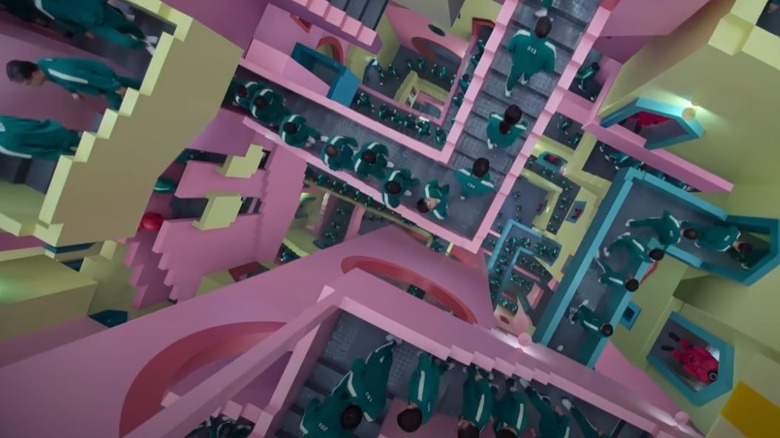“Squid Game” is more than just the most thrilling competition on TV — it also wears its cultural identity on its sleeve. Though it deals with universal themes such as the skewed distribution of wealth, the series is profoundly and unashamedly South Korean. In fact, Hwang Dong-hyuk’s survival thriller revolves heavily around a deadly series of Korean playground games that the country’s desperate, impoverished people play for the amusement of the jaded global elite.
One of the things to remember about “Squid Game” is that it thrives on carefully chosen locations and impressive set pieces but rarely overexplains them. While the show does a great job of depicting the everyday life and deep financial distress of the Squid Game participants and explaining each game for viewers who may be unfamiliar with them, it’s often content to leave its impressive locations unaddressed. Still, it doesn’t hurt to know more about the regions where the show’s events take place, so let’s make the viewing experience even more immersive by taking a look at where “Squid Game” was filmed.
Squid Game provides city views aplenty
The parts of “Squid Game” season 1 that don’t take place on the mysterious island where the titular games are played happen invariably in either South Korea’s capital Seoul or another major city, Incheon. In-universe, every single contestant whose backstories the show explores comes from this region — even Kang Sae-byeok (Jung Ho-yeon) and Ali Abdul (Anupam Tripathi), who are respectively from North Korea and Pakistan, operate in the area. Sightseeing-minded viewers are no doubt thrilled to hear that the city scenes were shot on location.
Major Seoul locations that make an appearance on “Squid Game” include high-profile destinations like Gangnam district’s Yangjae Citizen’s Forest Station, where Seong Gi-hun (Lee Jung-jae) plays a fateful game of Ddakji with the Salesman (Gong Yoo), and the towering, stylish IFC Mall, which plays host to his confrontation with Oh Il-nam (O Yeong-su) in the season finale, “One Lucky Day.” We also see the popular Namsan Park, where Gi-hun and Sae-byeok end up in episode 2, “Hell,” after their brief exit from the contest.
Seoul’s neighbor city, Incheon, heavily features during Gangster Deok-soo’s (Heo Sung-tae) episode 2 storyline, which takes him to Wolmido Island’s Wolmi Theme Park outside the city. Another prominent Incheon location on the show is Incheon International Airport, where Gi-hun almost boards a flight in “One Lucky Day” before deciding to challenge the people behind the game. Incidentally, if you think that filming at a huge, active airport can be tricky, you’re absolutely right. In 2023, the makers of the show had to issue an apology when the people filming a “Squid Game” season 2 escalator scene at the Incheon International Airport drew complaints for bossing passengers around.
The seedier side of Seoul is also present
Our unwitting tour guide to the darker side of Seoul is once again Gi-hun, who’s so openly proud of his roots in the city’s comparatively gritty Ssangmun-dong neighborhood that “Ssangmun-dong” becomes his in-series nickname. Cho Sang-woo (Park Hae-soo) also has roots in the same area, which makes Ssangmun-dong a prominent “Squid Game” location that we see many times on the show.
Other Seoul districts we see include Daeheoung-dong, where Gi-hun’s friend Jung-bae (Lee Seo-hwan) operates a bar. In episode 1, “Red Light, Green Light,” the pair visits the city center when they bet on horses at the Sangbong Intercity Bus Terminal, with Sae-byok later stealing the winnings. There’s also the Chang-dong district, where Gi-hun visits the Pokopang arcade, and Baegun Market in Gileum-dong, where Park-soo reveals his dire financial straits to Gi-hun.
The deliberately drab color schemes of “Squid Game’s” gloomier city locations are a harsh contrast to Seoul’s lavish cityscapes, not to mention the elaborate, colorful sets of the Squid Game itself. This plays well into the show’s overall theme of socio-economic disparity, of course. At times, the series can play the viewer’s emotions like a violin by its set design game alone, and it’s hardly a surprise that the best “Squid Game” season 1 episode, “Gganbu,” unleashes its heart-wrenching horrors in an idyllic mock village.
Set locations and tiny paradise islands
While the show’s city scenes take place in Seoul and Incheon, the majority of “Squid Game” season 1 — namely, the scenes taking place at the game compound — was filmed in an entirely different city. The show relies heavily on physical sets and practical effects, and as such, the makers of the show actually constructed the game’s many elaborate sets in full size. All these indoor scenes were filmed at a studio in the city of Daejeon. When the series actually shows us the deserted island the Squid Game compound is located on, the scenes are from a small, appropriately desolate isle called Seongapdo — one of the many in this particular area slightly west of the mainland.
Funnily enough, the island that the characters discuss the most in the series isn’t actually the one the games take place on. After all, the player characters have no way of knowing that they’re on the island in the first place. In “Gganbu,” Sae-byeok and Ji-yeong (Lee Yoo-mi) spend some time crafting a cocktail-fueled fantasy vacation to an island called Jeju. While the location doesn’t make an actual appearance on the show, Jeju is actually a very real South Korean province island located some 60 miles south of mainland. Though Sae-byeok and Ji-yeong never get to visit, the island indeed has many cool beach resorts and plenty of sights — and, no doubt, a Mojito or two on offer.

















Leave a Comment